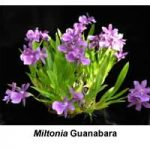For many years the genus Miltonia consisted of two different groups of plants. Those species found in Colombia carried circular, pansy-like flowers, while the flowers of those from Brazil were less well filled-in. About twenty years ago the Colombian miltonias were moved into the genus Miltoniopsis, while those miltonias from Brazil were retained in the genus Miltonia. Most orchid growers accepted this change but it left the Royal Horticultural Society with a problem in naming the hybrids, especially those few inter-generic hybrids that had already been made (and registered as miltonias). The solution adopted was to do nothing! Consequently, all hybrids made using Miltoniopsis and/or Miltonia species or hybrids are still registered under the name Miltonia.
There are about ten miltonia species , several of which will happily grow and flower in a ‘cosy’ shade-house in Melbourne. A ‘cosy’ shade-house is one fitted with a fibreglass roof, so that the plants can be kept dry during cold winter weather. They should be watered only on sunny mornings, so that their foliage can dry before nightfall. The most well known species is Miltonia spectabilis, a native of the Organ Mountains (and other areas) in eastern Brazil. In common with most other miltonia species, its pseudo-bulbs carry two narrow, yellow-green leaves, together with a number of basal sheaths. The inflorescences emerge from between these sheaths and bear one or two flowers with cream petals and sepals and a pink lip. My plants usually flower in January and February. Those plants grown in pots seem to flower more reliably than the one I mounted on tree fern, probably because I am unable to keep the latter uniformly moist during the heat of summer.
Most orchid books feature a photograph of Miltonia spectabilis var. moreliana, which has purplish flowers with a plum-coloured lip, rather than the type species. However, this variety has recently been shown to differ sufficiently from the type to be given its own specific name, Miltonia moreliana. Aside from its distinctive colour, its flowers are also larger and it is undoubtedly the most desirable of the miltonia species from the horticultural viewpoint. It flowers several months later than M. spectabilis.
Miltonia regnelli has flowers that are similar in colour to those of M. spectabilis, although they are a little smaller. It grows in eastern Brazil at moderate altitudes, and therefore it may also be grown without heat in Melbourne (I have no experience in growing this species). Miltonia flavescens, a species that bears up to ten yellow flowers per inflorescence, comes from hot lowlands in Brazil. Although I have found that it grows satisfactorily in a Melbourne shade-house, it refuses to flower under these conditions. Miltonia clowesii has flowers with orange petals and sepals marked with brownish bars and blotches. It will grow and flower without heat but does better with winter warmth. M. candida, which has chestnut-brown and yellow petals and sepals and a pink and white lip, also prefers winter warmth.
Miltonia hybrids are probably seen more often on our show benches than the species from which they were bred, probably because most exhibit hybrid vigour and can be grown without heat. Miltonia bluntii is often exhibited as a species but in reality it is a natural hybrid between M. spectabilis and M. clowesii. Two other common hybrids are M. Anne Warne (M. bluntii x M. spectabilis) and M. Guanabara (M. Anne Warne x M. regnellii). These miltonia hybrids seem to do best if pot-grown, using a potting mix of medium-sized pine-bark. I add a little chopped Sphagnum moss to the bark, so that the mix retains more moisture. The plants should be watered and fertilised regularly from spring to autumn but given a drier rest after flowering. They enjoy good light and make good companion plants for cymbidiums.



